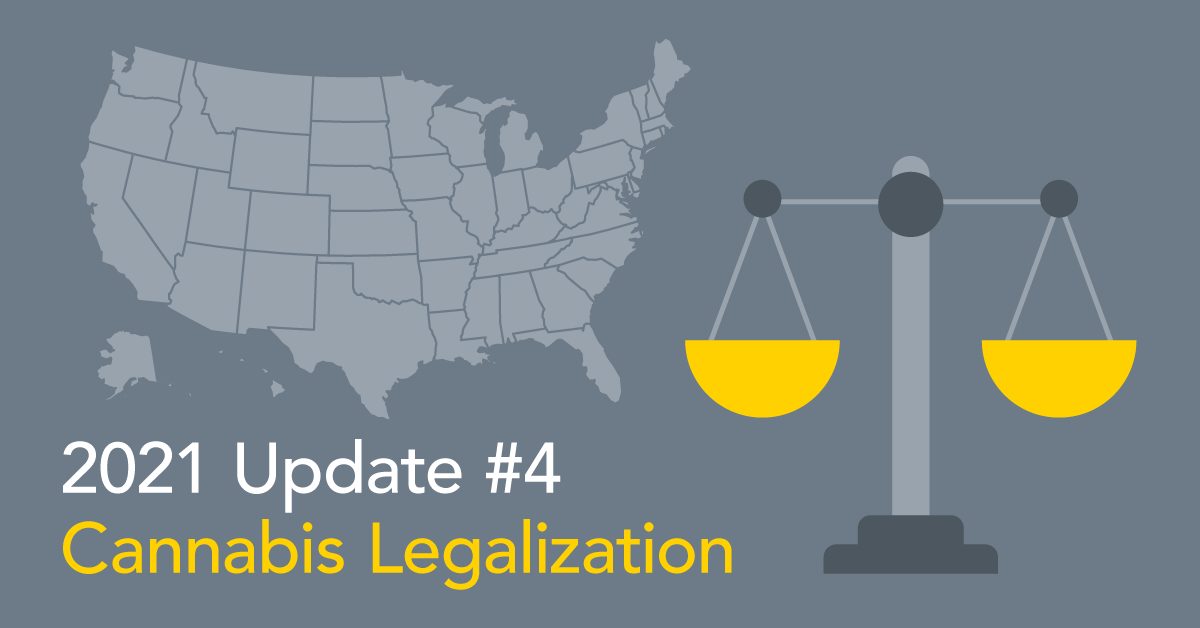
Cannabis Reform: Many Steps Forward and Few Steps Back
Cannabis reform remained a topic of conversation with a range of activity at both the federal and state levels:
- 5 states legalized recreational cannabis through legislative efforts.
- 1 state legalized medical cannabis use.
- 2 states had recreational legislation succeed in either the house or the senate, but not both chambers, and will revisit in 2022.
- 2 state supreme courts reversed successful 2020 ballot initiatives.
- 3 U.S. senators introduced a draft reform bill.
Here are a few thoughts on the impact of all this activity on 2021 and how it might influence cannabis reform in 2022.
THE MAJORITY OF U.S. ADULTS HAVE ACCESS TO LEGAL RECREATIONAL CANNABIS
The legalization of cannabis in 2021 in the Northeast Corridor (CT, NJ, NY), Virginia, and New Mexico fell just shy of allowing most U.S. adults to legally use recreational cannabis (at 43 percent).1 Although legislative efforts in these five states did not push the needle to a majority of adults who can legally use cannabis, the legislation that passed will influence future and existing legislation.
As we wrote back in June 2021, the Northeastern trio of states (CT, NJ, NY) recognized the shortcomings of cannabis tests that use oral fluid, hair, or urine to look for tetrahydrocannabinol (THC). Specifically, these tests can return positive results for cannabis use that occurred days, weeks, or even months earlier. This leads to unfair outcomes for employees while also creating problems for employers who are compelled to discipline or even fire these employees. To help ensure fairer outcomes, Connecticut’s law has specific language that prohibits employers from penalizing an employee based solely on a positive result from detection of the inactive THC metabolite 11-Nor-9-carboxy-Δ9-tetrahydrocannabinol. I would expect other states to adopt similar laws and regulations.
A FEW STEPS BACKWARD
Interestingly, in 2021 cannabis reform efforts also took a couple of steps backward. In Mississippi and South Dakota, state supreme courts in both states reversed the will of the voters who had approved legalizing cannabis.
In November 2020, South Dakota voters, by a 54-46 percent vote, approved a state constitutional amendment to establish a medical marijuana program and legalize recreational adult use of cannabis and the sale of hemp. Just two weeks ago, the South Dakota Supreme Court upheld a lower court’s ruling that the voter-approved amendment violated the state’s rule that constitutional amendments can only have a single subject. Not to be deterred, South Dakota cannabis reformers will attempt to bring back a ballot initiative in 2022.
In Mississippi, voters also approved a ballot initiative to legalize medical marijuana with an overwhelming 74 percent voting yes. But the Mississippi Supreme Court invalidated that initiative based on the process that was used to gather the signatures to place the item on the ballot. Given the landslide vote in favor of the medicinal program, I would expect the Mississippi legislature to take up this issue in 2022.
2022 INITIATIVES TO WATCH
Although efforts in MS and SD ultimately failed in 2021, 91 percent of U.S. adults cite that cannabis should be legal for either recreational or medical use.2 With such an overwhelming majority of adults favoring cannabis legalization, it shouldn’t be surprising that ballot initiatives in several historically red states are gaining momentum. Republican governors in these states (AR, ID, OK, OH, NE, SD, WY) will be watching as voters push to legalize either recreational or medical cannabis. In New Hampshire, legislators are discussing a constitutional amendment to the ballot to legalize adult recreational use.
FEDERAL LEGALIZATION OF CANNABIS IMMINENT?
After the election in November 2020, many observers believed it was only a matter of time before Congress would push to legalize cannabis. In fact, just a few weeks after the November election, the House of Representatives passed its legal cannabis bill. That effort died when the Senate didn’t act before January 2021 when the new Congress was sworn in.
Since that time, it’s been a wait-and-see game. Senators Chuck Schumer (D-NY), Corey Booker (D-NJ), and Ron Wyden (D-OR) have introduced legislation that would, among other things, remove cannabis from the Controlled Substances Act. It would also recognize state law as controlling the possession, production, or distribution of cannabis and move regulatory authority to the Food & Drug Administration from the Drug Enforcement Agency. In the House of Representatives, a similar and far-ranging bill related to decriminalization has been introduced.
While 2022 could yield similar results to what occurred in 2021, I believe it’s still going to be a struggle for Democrats to pass a federal decriminalization bill through both houses in 2022 —despite the public’s overwhelming support to legalize cannabis possession and use. There are still significant differences within the Democratic caucus on which provisions to approve, and we’re moving into a hotly contested battle to control Congress in the mid-term elections. There simply are very few legislative days left to make this push.
Should Congress overcome the aforementioned obstacles to passage and act on cannabis reform, it will be critical for any legislation to contemplate policies to mitigate or ameliorate the potential negative impacts that follow legalization, particularly the rise in impairment behind the wheel or at the workplace. Federal legislation could go a long way toward helping create a national standard for workplace cannabis testing that balances employers’ need for safety with that of fairness for employees. For example, the federal legislation should include provisions similar to what Connecticut passed (as described above) to limit the use of tests that only identify a non-impairing metabolite of THC.
IN SUMMARY
As 2021 comes to an end and we look ahead to 2022, we see that state legislatures and ballots have become the laboratory for new policies to try to help create safer workplaces and roads while also giving adults the right to use cannabis. I would expect this trend to continue in 2022 and hope to be pleasantly surprised by the creation of public policies that help employers and employees more easily navigate the legal cannabis landscape.
First, the most effective policies will recognize the limitations of current cannabis tests and allow employers to add new cannabis testing solutions designed for an era of legal use. Second, employers need to be able to maintain safety without worry that testing employees for cannabis exposes them to litigation for unfair practices — legislators should follow Connecticut’s lead and specify tests that provide positive results that do not correlate with impairment. Finally, employees want fair treatment, and they want to be safe. To accomplish this, legislators should pass laws that accommodate the latest technology for point-of-care testing.

December 16, 2021
By DOUG BOXER
Chief of Policy + Strategic Initiatives
Share














